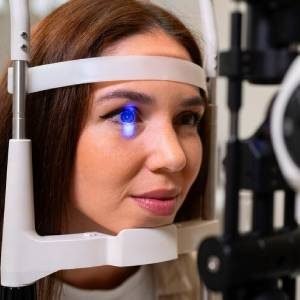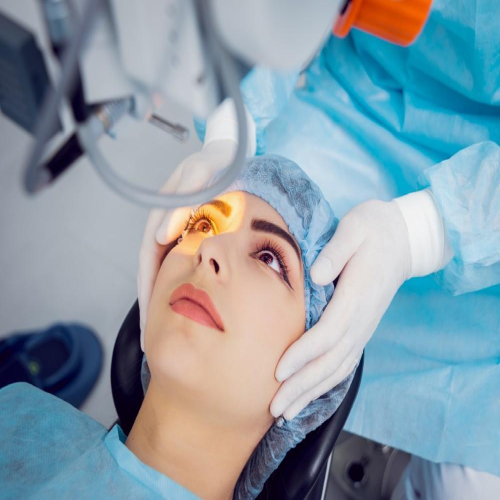About Refractive Surgery
Refractive surgery is a medical procedure designed to correct common vision problems, such as nearsightedness, farsightedness, and astigmatism, reducing or eliminating the need for glasses or contact lenses. This type of surgery involves reshaping the cornea, the eye’s clear, dome-shaped surface, to improve the way light is focused on the retina. One of the most popular methods is LASIK (Laser-Assisted In Situ Keratomileusis), which uses a laser to create a thin flap in the cornea, reshaping the underlying tissue to correct vision.
Symptoms of Refractive Surgery
- Hazy vision
- Eye dryness
- Light sensitivity
- Foreign body sensation
- Night vision issues

Causes of Refractive Surgery
Nearsightedness (Myopia):
- Visual Disturbances: Difficulty seeing distant objects clearly, while close objects appear clear. This is due to the eye being too long or the cornea being too curved.
Farsightedness (Hyperopia):
- Visual Disturbances: Difficulty seeing close objects clearly, while distant objects may be seen more clearly. This occurs when the eye is too short or the cornea is not curved enough.
Astigmatism:
- Distorted Vision: Blurred or distorted vision at all distances caused by an irregularly shaped cornea or lens, leading to multiple focus points.

Our Refractive Surgery Treatment Options
LASIK (Laser-Assisted In Situ Keratomileusis): A flap is created on the cornea, and laser reshapes the underlying tissue to correct vision issues such as myopia, hyperopia, and astigmatism.
PRK (Photorefractive Keratectomy): The outer layer of the cornea is removed, and the laser reshapes the cornea to improve vision, often used for patients with thinner corneas.
SMILE (Small Incision Lenticule Extraction): A minimally invasive procedure where a small tissue lenticule is created and removed through a tiny incision, primarily for myopia correction.
LASEK (Laser-Assisted Sub-Epithelial Keratectomy): Similar to PRK, but the outer layer (epithelium) is preserved and replaced after laser reshaping of the cornea.
Epi-LASIK: A variation of LASEK, where the epithelial layer is separated with a special tool, and then the cornea is reshaped with a laser.
Phakic Intraocular Lenses (IOLs): Insertion of a lens inside the eye without removing the natural lens, for patients with very high refractive errors not suitable for LASIK or PRK.
When You Need
Treatment Refractive Surgery



Significant Refractive Errors:
- Nearsightedness (Myopia): Difficulty seeing distant objects clearly.
- Farsightedness (Hyperopia): Difficulty seeing close objects clearly.
- Astigmatism: Distorted or blurred vision due to an irregular cornea or lens.
- Presbyopia: Age-related difficulty focusing on close objects (less commonly treated with surgery but may be considered).
Stable Vision Prescription:
- Consistent Vision: Your prescription has remained stable for at least a year, indicating that your vision is not changing rapidly.
Desire to Reduce Dependence on Glasses or Contact Lenses:
- Lifestyle Convenience: If you wish to reduce or eliminate the need for corrective eyewear for daily activities, sports, or convenience.
Frequently Asked Questions
The most common types of refractive surgery include:
- LASIK (Laser-Assisted In Situ Keratomileusis): Uses a laser to reshape the cornea.
- PRK (Photorefractive Keratectomy): Removes the outer layer of the cornea to reshape it.
- SMILE (Small Incision Lenticule Extraction): Removes a small piece of corneal tissue to improve vision.
Ideal candidates are typically over 18 years old, have stable vision for at least a year, and have healthy corneas. A comprehensive eye exam and consultation with an ophthalmologist will determine if you are a good candidate for the procedure.
- SMILE (Small Incision Lenticule Extraction) is a newer, minimally invasive refractive surgery where a small disc of corneal tissue is removed through a small incision. It is primarily used to treat nearsightedness and offers a faster recovery with less disruption to the corneal surface than LASIK or PRK.
Most refractive surgeries take about 10 to 20 minutes for both eyes. However, preparation and post-procedure care at the clinic can extend your visit to around 1 to 2 hours.
24 / 7 HOURS SERVICE
